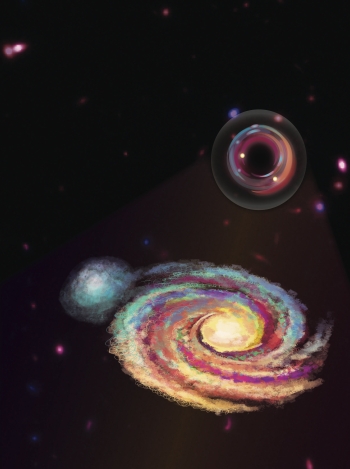Telescopes in Atacama Desert capture extreme starburst galaxy warped into fiery ring

The hyperluminous infrared galaxy PJ0116-24, gravitationally lensed into a structure known as an Einstein ring. The Atacama Large Millimeter/submillimeter Array reveals cold gas emission at submillimeter wavelengths (shown here in blue), while the European Southern Observatory’s Very Large Telescope's new Enhanced Resolution Imager and Spectrograph traces ionized gas heated by star formation (shown in red). This image is featured as the European Southern Observatory’s Picture of the Week. Image credit: ALMA (ESO/NAOJ/NRAO) / ESO / D. Liu et al.
Ten billion years in the past, a rare population of extreme galaxies formed stars at rates more than 1,000 times faster than our own Milky Way galaxy.
This was just a sign of the times; while there are no galaxies in the universe today that come close to their productivity as stellar factories, they are captured during an epoch — aptly named “cosmic noon”— when today’s galaxies formed half of their stars within just a quarter of the universe’s age.
Yet, understanding these monstrous galaxies is complicated by their thick curtains of interstellar dust that block the escape of optical light, necessitating observations at other wavelengths.
In a recent study published in Nature Astronomy, an international team of astronomers — including postdoctoral research scholar Patrick Kamieneski and graduate student Nicholas Foo, both with Arizona State University's School of Earth and Space Exploration — used telescopes operating at infrared and millimeter wavelengths to study one of the most luminous starburst galaxies ever discovered, named PJ0116-24.
The light from this object — emitted more than 10 billion years in the past, when the universe was only 3 billion years old — took a circuitous path before reaching Earth. Through a phenomenon known as gravitational lensing, the light from this distant starburst passed by a more nearby galaxy, which “lenses” and magnifies the background object. This results in a rare, warped structure known as an Einstein ring, the image of which is currently featured as the European Southern Observatory’s Picture of the Week.
The team employed this “cosmic telescope” to reveal small structures that are too small for most telescopes to resolve on their own.
Using the new Enhanced Resolution Imager and Spectrograph instrument of the European Southern Observatory’s Very Large Telescope, along with the Atacama Large Millimeter/submillimeter Array — both located in Chile's Atacama Desert — the team observed the distribution of ionized and molecular gas in PJ0116-24.
The ionized gas traces where massive stars have recently formed, while the molecular gas is the essential fuel for future star formation. The observations also reveal how the gas is moving within the galaxy.
While it once seemed that most of the extreme starburst galaxies we see in the distant universe had to have been driven by mergers and collisions between galaxies, the gas kinematics of PJ0116-24 indicate instead that this galaxy consists of a relatively stable rotating disk, not too dissimilar from the Milky Way.
“This tells us that galaxies in the early universe were somehow able to assemble stars very rapidly in isolation, and don't need to be triggered only by ‘trainwreck’ mergers of gas-rich galaxies. This is starkly different from the most luminous galaxies in the universe's more recent history,” said Kamieneski, who is a co-author on the study.
Discovered as part of the PASSAGES (Planck All-Sky Survey to Analyze Gravitationally-lensed Extreme Starbursts) project, PJ0116-24 is going through quite a growth spurt. The researchers estimate that it has already formed nearly three times the number of stars that exist in the Milky Way, but within only a quarter of the universe’s age.
“The combination of telescopes covering a range of wavelengths offers a rare insight into the process of how gas fuels the formation of stars in galaxies billions of years ago,” said Foo, also a co-author of the study.
“Studies of extreme, boundary-pushing objects like PJ0116-24 are helping to improve our understanding of how galaxies evolved in the first few billion years after the Big Bang,” said Kamieneski. “With the help of gravitational lensing, we can draw connections between the universe's past and present.”
More Science and technology

James Webb Space Telescope opens new window into hidden world of dark matter
NASA’s James Webb Space Telescope (JWST) has revealed unparalleled details about the early universe: observations of young galaxies with unexpectedly elongated shapes that challenge established…

US Department of Energy selects ASU and DCX to pioneer new ways to power data centers
The U.S. Department of Energy has selected Arizona State University and DCX USA, LLC, as key research partners for its Microreactor Application Research Validation and Evaluation (MARVEL) program, an…

From the lab to your headphones, new podcast brings ASU research to you
What do you get when an evolutionary biologist, an engineer and an anthropologist walk into a recording studio?At Arizona State University, it turns out you get "Lab Coat Optional," a new podcast…

